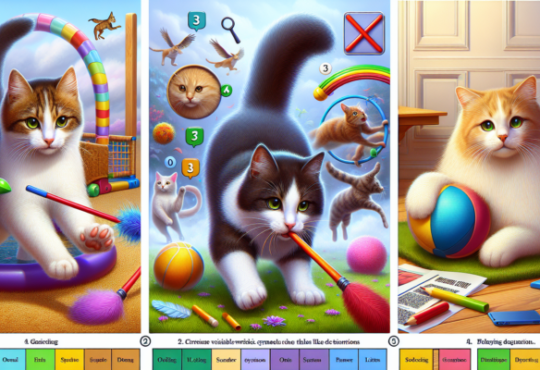
Introducing Cats and Newborns: Tips for a Smooth Transition
Essential Techniques for Safely Introducing Your Newborn to Your Cat
Cats are fascinating and intricate animals, often displaying behaviors that can leave their human companions bewildered. To ensure a smooth transition when welcoming a newborn into your home, it is imperative to deeply understand these unique behaviors. Cats possess a natural territorial</b) instinct, and their emotional health is intricately linked to their environment. By gaining a comprehensive understanding of your cat’s specific needs and preferences, you can create a nurturing setting that benefits both your feline friend and your new baby, leading to a harmonious living situation for the entire family.
Cats communicate through a combination of body language, vocalizations, and scent marking, all of which can be influenced by alterations in their environment. When a baby arrives, your cat may exhibit signs of stress or anxiety triggered by unfamiliar sounds and smells that disrupt their established routine. Recognizing these behaviors—such as hiding, excessive grooming, or changes in eating habits—allows you to proactively address your cat’s emotional needs during this significant transition. This awareness paves the way for a smoother adjustment period for all family members, fostering a more balanced household.
Furthermore, cats are creatures of habit and tend to thrive on established routines. The arrival of a newborn can significantly disrupt these familiar patterns, leading to observable behavioral changes. For instance, a cat that previously relished lounging in a specific spot may start to avoid that area if it becomes associated with the baby. It’s crucial to comprehend these subtle behavioral shifts to encourage peaceful coexistence between your cat and your newborn. By doing so, you ultimately enhance the bond within your family, creating a nurturing environment for everyone involved.
Key Considerations for Facilitating a Smooth Transition Between Your Cat and Newborn
- Gaining insight into your cat’s behavior is vital when preparing for your newborn’s arrival.
- Gradually adjusting your cat’s routine can significantly alleviate the transition and minimize anxiety.
- Introducing your cat to the baby’s scent ahead of time fosters familiarity and comfort.
- Facilitating safe, supervised introductions between your cat and baby is crucial for nurturing positive interactions.
- Establishing clear boundaries for your cat around the baby is essential for maintaining a harmonious environment.

Thorough Strategies for Preparing Your Cat for the Arrival of a New Baby
Preparation is vital for ensuring a smooth transition for your cat as you embrace the arrival of a new baby into your household. An effective starting point involves gradually making changes to your living space that will accompany the baby’s arrival. This may include setting up the nursery and introducing essential items like cribs, strollers, and baby toys that will soon become integrated into your daily routines.
Allowing your cat to explore these new items before the baby’s arrival can significantly diminish anxiety and assist them in adapting to the impending changes. For instance, positioning baby-related items in areas where your cat typically spends time can help them acclimate to new scents and visual stimuli. Furthermore, it is crucial to maintain your cat’s routine as consistently as possible during this transitional phase, ensuring they continue to feel secure amidst the changes.
Cats thrive on predictability; therefore, keeping regular feeding times, play sessions, and cuddle moments can provide them with a sense of stability. If you anticipate major shifts in your daily schedule after the baby arrives, consider gradually modifying your cat’s routine beforehand. This proactive approach can help alleviate feelings of neglect or confusion that your cat might experience when the baby inevitably becomes the center of attention.
Strategies for Introducing Your Cat to the Baby’s Distinct Scent
Once you’ve adequately prepared your cat for the newborn’s arrival, the next crucial step is to introduce them to the baby’s unique scent. Cats possess a remarkable sense of smell and heavily rely on this ability to navigate their surroundings. To facilitate this introduction, consider bringing home a blanket or an item of clothing that has been in close contact with the baby.
Encouraging your cat to sniff and explore this item at their own pace is essential. This process allows them to associate the new scent with something familiar and non-threatening. In addition to clothing or blankets, consider utilizing pheromone diffusers or sprays specifically designed for cats. These products can help create a soothing environment that alleviates your cat’s anxiety regarding the new family member.
By combining these methods, you can foster a positive association with the baby’s scent, making it easier for your cat to accept the new addition to the family when they finally meet in person. This gradual introduction plays a pivotal role in helping your cat adjust to the changes in their environment, ultimately contributing to a more harmonious household.

Ensuring Safe and Supervised Interactions Between Your Cat and Newborn
The first encounter between your cat and the newborn should be approached with the utmost care and attention. Supervised introductions are essential for ensuring the safety of both your baby and feline companion while fostering a positive relationship from the outset. When you believe the time is right for this initial meeting, choose a calm and relaxed moment for both your cat and baby to create an ideal atmosphere for a successful introduction.
It’s advisable to hold your baby securely in your arms while sitting on a comfortable surface where your cat can approach at their own pace. Throughout this introduction, pay close attention to your cat’s body language. Signs of curiosity may include slow blinks or gentle sniffing, while signs of distress could present as hissing or an arched back.
If your cat exhibits signs of anxiety or discomfort, allowing them to retreat and take space is crucial. This approach respects your cat’s boundaries and helps them feel more secure in their environment. Over time, with consistent positive interactions, your cat will likely become more comfortable and accepting of the baby, fostering a loving relationship between them.
Setting Clear Boundaries and Rules for a Peaceful Household
Establishing clear boundaries and rules is vital for maintaining a peaceful coexistence between your cat and your newborn. As your baby grows and begins to explore their environment, teaching them how to interact safely with your cat becomes increasingly important. This includes explaining that pulling tails or grabbing fur is unacceptable behavior that should be avoided to ensure the safety and comfort of both parties.
Teaching your child the significance of gentle touch early on can help prevent unintentional harm. Alongside educating your child about appropriate interactions with the cat, it is equally critical to set boundaries for your cat. For example, designating specific areas of the home—such as the nursery—as off-limits for the cat will create a secure space for both your baby and your feline friend.
Utilizing baby gates or closed doors can effectively establish these boundaries while allowing each party to have their own designated space. This proactive measure benefits both your cat and your newborn as they learn to navigate their shared environment, promoting safety and comfort.

Creating Safe and Comfortable Environments for Your Cat During Changes
Designing secure areas for your cat is crucial in ensuring they feel protected amid the adjustments that come with a new baby. Cats generally seek out quiet and secluded spots when feeling overwhelmed or stressed. Providing designated areas—such as cozy beds or elevated perches—can empower your cat with a sense of ownership over their environment and offer them a retreat when needed.
In addition to creating physical spaces, consider incorporating elements that cater to your cat’s natural instincts. Scratching posts, climbing trees, and interactive toys can provide mental stimulation and physical activity, serving as effective outlets for any pent-up energy or anxiety. Enriching your cat’s environment in this manner supports their overall well-being and aids in their adjustment process as they acclimate to the presence of the new baby.
Monitoring and Interpreting Your Cat’s Behavior Around the Baby
As your baby grows and begins to explore their surroundings with increasing vigor, closely monitoring your cat’s behavior around them becomes increasingly important. Cats can be unpredictable, and even the gentlest feline may react unexpectedly when startled or provoked. Regularly observing the interactions between your cat and baby will enable you to identify potential issues before they escalate into significant problems.
Be vigilant for signs of stress or discomfort in your cat during these interactions. If you notice any aggressive behavior or indications of fear—such as hiding or avoiding contact—it may be necessary to intervene and temporarily separate them. This proactive approach not only protects both parties but also reinforces positive associations over time as they learn to coexist harmoniously in their shared environment.
Effective Strategies for Building a Positive Relationship Between Your Cat and Newborn
Fostering a positive relationship between your cat and newborn is an ongoing journey that requires patience, consistency, and a proactive approach. Engaging both parties in shared activities can significantly strengthen their bond over time. For instance, allowing your baby to participate in supervised feeding sessions can create shared experiences that promote trust and familiarity between them.
Incorporating playtime into their interactions can also be beneficial for both your cat and baby. Utilizing toys that encourage gentle play can help establish positive associations while allowing both parties to engage in enjoyable activities together. As your child matures, teaching them to respect boundaries while interacting with the cat will further solidify their relationship, laying the foundation for a strong bond.
Developing a harmonious dynamic between your cat and newborn takes time and effort, but the rewards can be immense. By gaining a better understanding of feline behavior, adequately preparing for the changes ahead, and encouraging positive interactions, you can create an environment where your cherished pet and new family member thrive together.
Frequently Asked Questions About Introducing a Newborn to Your Cat
What is the best approach for introducing a newborn to a cat?
The most effective method for introducing a newborn to a cat involves allowing the cat to become familiar with the baby’s scent prior to the baby arriving home. Once your baby is home, it’s essential to supervise all interactions between your cat and the newborn to ensure the safety of everyone involved.
How can I prepare my cat effectively for the arrival of a newborn?
To adequately prepare your cat for the arrival of a newborn, gradually introduce changes to their routine, such as relocating their feeding and sleeping areas to the baby’s room. Additionally, playing recordings of baby sounds can help your cat acclimate to the new noises they will soon encounter.
What warning signs indicate my cat may not be adjusting well to the newborn?
Indicators of potential adjustment issues for your cat may include aggressive behavior, excessive hiding, or noticeable changes in eating or grooming habits. If you notice any concerning behaviors, it’s important to consult with a veterinarian or an animal behaviorist for professional guidance to ensure your cat’s well-being.
How can I encourage a positive relationship between my cat and newborn?
To facilitate a positive relationship between your cat and newborn, ensure your cat receives sufficient attention and affection, even after the baby arrives. Additionally, create safe zones where the cat can retreat when they need a break from the baby’s presence to help them feel secure.
What precautions should I take when introducing my newborn to my cat?
Important precautions when introducing your newborn to your cat include keeping the cat’s claws trimmed, never leaving the baby unattended with the cat, and teaching your baby to be gentle and respectful towards the cat to promote safety for both.
The Article : How to Introduce a Newborn to a Cat Appeared First On Unity Pets.
The Article Introducing a Newborn to a Cat: Tips for a Smooth Transition Was Found On https://limitsofstrategy.com
The Article Tips for a Smooth Transition When Introducing Cats and Newborns First Appeared ON
: https://ad4sc.com












It’s so insightful to read about introducing a newborn to a cat, as I have just gone through a similar experience. I remember being particularly concerned about my cat’s reactions to the new sounds and smells. We found that slowly acclimating her to baby items—a worn blanket, toys, and even playing recordings of baby sounds—helped ease her anxiety. Creating safe spaces for both the cat and the baby was crucial; it allowed our feline friend to retreat when things felt overwhelming.